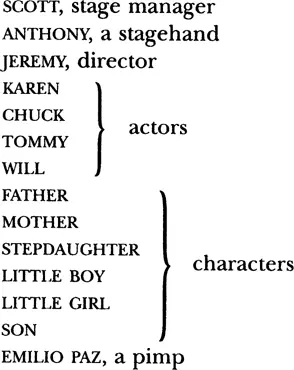The Son (pointing his finger at his head) parallels the action of the Boy pointing a revolver at his head. The shot is fired, the Boy falls, the lights go out, and the actors rush behind the scrim as the rest of the family disappears off stage. Pandemonium ensues—shouts, screams, falling furniture. The only light is provided by an actor (Chuck) who brandishes a desk lamp. The Boy’s body is carried on stage as the actors gather around him. After a call for more light, Chuck turns the lamp away to kick over a chair and free the lamp cord. When he turns the lamp back on the body, it is gone (a quick moving hinged trap which drops the boy actor onto soft mattresses beneath the stage).
Power is restored following a flickering of the lights, and once again we are back in the drab, grey, empty rehearsal stage. The actors are in a state of confusion and panic, searching the theatre for signs of the characters. Gradually, they gather their things and leave the theatre. Only the director (Jeremy) remains, surveying the stage and trying to absorb what he has experienced. Unexpectedly, once again, the scrim begins to tremble and the loading door begins to rise. We see the six characters again, brilliantly back lit, with snatches of their speeches heard over the loudspeakers. Suddenly, all six fall forward on their faces with a loud thud. It is another illusion—a gigantic Polaroid photograph. Jeremy hisses “Jesus” and runs offstage. Blackout. Houselights up. We did not take a curtain call for the sake of maintaining the illusion we had created, but this is entirely at the discretion of the director and the cast.
Some additional hints in rehearsal: Make certain that you maintain a distinct difference in style between the actors and the characters. The actors should be jaunty, relaxed, colloquial, “modern.” The characters should be formal, a little stiff. You might also (as we did) paint their faces and hands with pasty white makeup, adding dark highlights under the eyes, to emphasize their otherworldliness. Don’t overdo this or it will look like a horror movie effect. When the Father and Stepdaughter refer to the Author, have them actually talk to him (find a spot in the balcony where he’s sitting). The most difficult role in the play is that of the Mother, since she has so little to say and must always be the image of grief. Anna Magnani is a good image for her—a heavy, hollow-eyed if once sensual woman. The clothes of the Father and the Son should be significantly better-tailored than those of the rest of the family which are neat but worn. The actors should wear relaxed street clothes, sneakers, and tee shirts. The voice of the technician in the booth can be recorded—but best to use an actual technician rather than an actor.
The production should make the audience’s flesh creep. It’s a metaphysical ghost story about the transparent nature of reality.
CHARACTERS

Six Characters
in Search of an Author
When the audience enters, the curtain is up and the stage is abandoned. The theatre is empty, there is no set on stage, the house is dark. The audience must have the feeling that it has happened into a theatre where not a performance but a rehearsal is about to take place.
1 comment